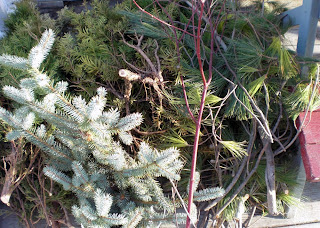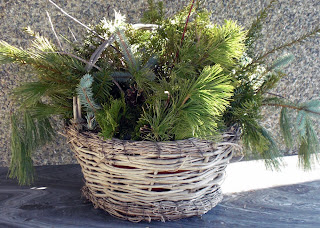"What I want is a
potager!," I explained to my husband, "not
just a vegetable garden." It will have to
look as good as the food it grows. That is what I set out to do this past Spring - start my "potager." A trip through the Ontario province of Canada helped illustrate my vision. The country side was dotted by proud farms - rightly so - with geometrical rows of crops, arrangements of flowers, and shrubs all surrounding stately, brick homes. I had never seen such beautiful farms. I found more inspiration in two books,
"Designing the New Kitchen Garden" and
"Four-Season Harvest." (I love books.)
I confess I haven't grown a vegetable since I was a little girl growing up in Wisconsin. I couldn't eat green beans for
years for all the beans we picked! (And then froze so we could eat them all winter long, too.) Fortunately for me then, my old labrador loved all food - including green beans. Fortunately for me now, my taste for them has grown back. I guess I just didn't get around to starting that vegetable garden before we moved again, and then again. Now, I'm not sure how I ever got along without one!
So, I am a beginner really when it comes to gardening vegetables. But I sure do have a taste for it so it can only get better from here. The idea of a potager intrigued me because it could be ornamental and beautiful - a focus of the garden, and also grow a good amount of food (and flowers) in a small space.
First, I decided where I was going to begin. And that was in the back, back yard. Ideally, a kitchen garden should be right outside the kitchen but that just wasn't going to work for me. Not the best sun, not the best site with a deck that we plan to turn into a four-season room - future construction. So I decided between the tool shed and the compost - easy access to both to tend the garden. I love "making the journey" back to my little potager before dinner. It is a "passage" to great food. A ritual. Here's the spot before ...
Here's the frame work I started with ...
I really want the raised beds to be made from stacked stone but I don't have the budget for that right now with all the other garden projects I've got going on so we just framed the beds with wood temporarily. I love stone. I want to see it age and grow with the garden, to feel permanent. I have allowed for the thickness of the future stone walls in my layout. Here the "framed" beds are waiting to be filled up (viewed from inside the shed).
I placed a thick layer of newspaper in the bottom and started filling. I had a nice pile of old sod that broke down over the winter to start with as a base. Then mixed in some compost, potting soil, peat moss and top soil.
I will add more "flat" beds to either side of the raised. This year I only made two. Eventually I will add an edger of brick or pavers, maybe some hardscaped paths in between, some evergreens for winter structure. I used temporary posts and string to get the straight lines. Some fencing left here by the previous owners became makeshift tomato cages and some old curtain rods became support posts - whimsy.
Things got off to a good start and then just kept on growing!
Many people had terrible tomatoes here in the Northeast this past season. But we planted heirloom tomatoes we bought from Cross Island Farms (a local organic farm). They did very well and tasted divine ...
My husband wanted to plant red cabbage to make sauerkraut. Note, never plant red cabbage as a "divider" in your raised bed. I thought it would be pretty with that purple color and all. Well, next year it will have a nice "flat" bed all to itself. Positive outcome - the sauerkraut is delicious and I will never be able to eat canned again - oh, and I can't say I was a big sauerkraut fan to begin with, but I am now - that's how good it is!
The other advantage to these raised and flat beds is that I can keep track of what I plant in them and then rotate the plant families each year, i.e. Apiaceae or carrot family (carrots, celery, parsley, etc.) , Solanaceae or nightshade family (eggplant, pepper, tomato, etc.), to reduce the chance of disease and pests.
I planted flowers in the flat beds this year because I had the seeds already and I wasn't sure of everything I wanted to plant just yet. More veggies will be in these beds next year but flowers will still be a mainstay to attract the bees, beneficial insects and birds. Most of the beds are edged in marigolds (rabbit deterrent) and nasturiums. Above are cosmos, sunflowers, and zinnias.
So, this first year we had a truck load of tomatoes - cherry and slicing, herbs, green beans (yes, green beans), cucumbers, cabbage, lettuces (still going!), and peas. Next year we'll add more. Maybe brussel sprouts, some squash, swiss chard and kale, beets ... I can't wait to experiment growing vertically. I can envision an arbor and blue berry bushes. I see a cold frame over one of the beds, or a row cover. Rhubarb will be planted next to the compost. We'll tuck some strawberries in there, too. And let's not forget cover crops! I'll be busy planning and sketching all this winter.



















































